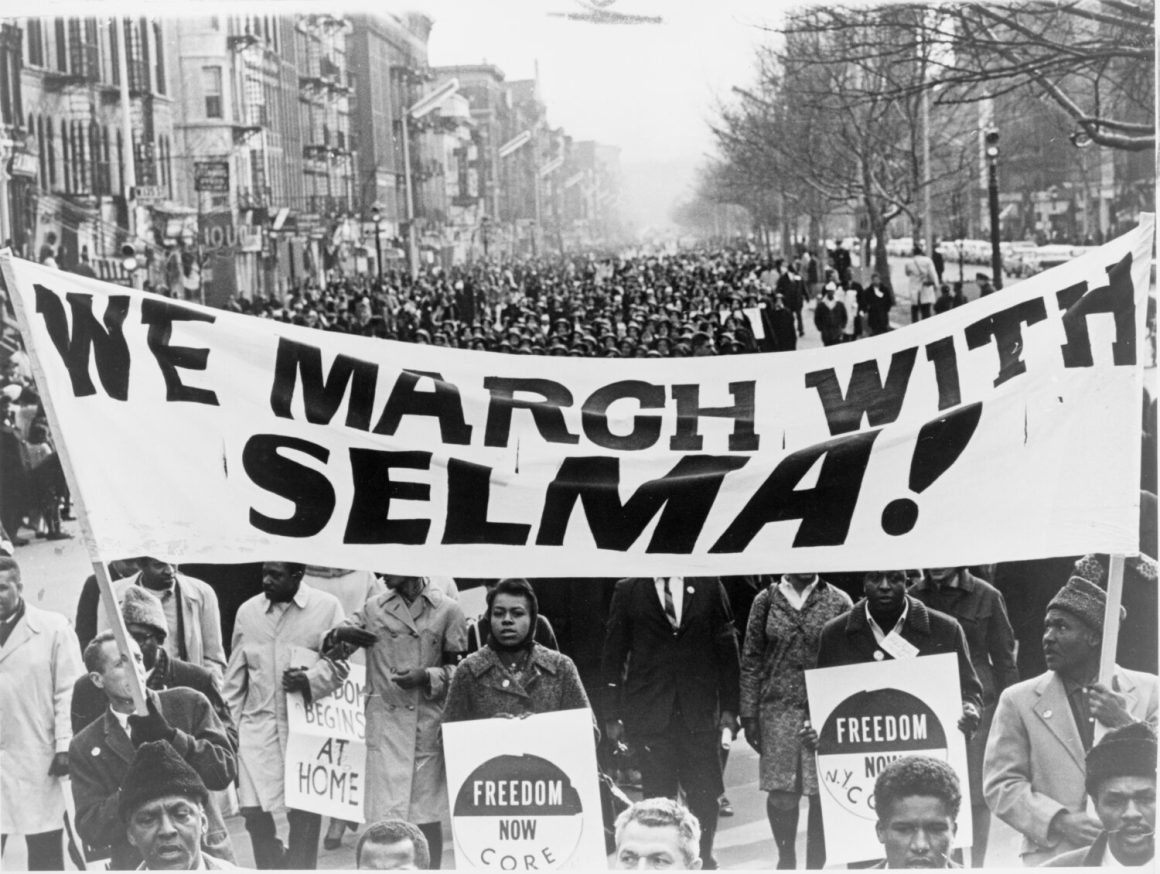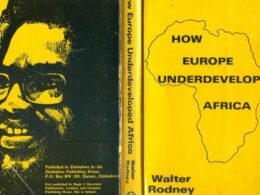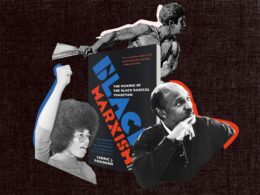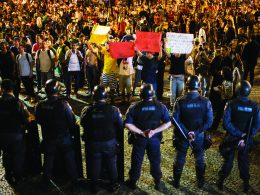By Tamar Wilson, Socialist Alternative (our sister organisation in the United States)
The Black working class, minority communities, and American poor were under consistent economic assault prior to the COVID-19 pandemic, but have now entered a state of emergency in this sustained capitalist crisis. Tens of thousands of Black and brown people have died from the virus, millions more have lost their jobs or face underemployment in the wake of the economic depression, and millions more suffer from a critical lack of housing security with a looming eviction crisis.
The Republican right is carrying out historic attacks on the right to vote for millions of Americans, mostly Black and Latino people. This amounts to a GOP* (* ‘Grand Old [Republican] Party) -led and Democrat abetted erosion of the landmark legislative achievement of the Civil Rights Era: the Voting Rights Act of 1965.
Over 350 bills in 43 states have been filed this year alone restricting voting rights. Arizona is sponsoring a case before the Supreme Court that could invalidate key sections of the bill. That these attacks follow in the wake of the GOP’s loss of traditional Republican stronghold states Arizona and Georgia is no coincidence. The historic Black Lives Matter and Free Palestine movements have showcased a growing rejection of their right-wing agenda among a multiracial coalition of voters, and they are determined to depress voting access however they can.
It’s imperative that we recall the lessons of how voting rights were won in order to protect them now.
How we won the Voting Rights Act of 1965
The Voting Rights Act was the crown jewel in a trio of legislation passed in the 1960s Civil Rights era that, including the Civil Rights Act of 1964 and Fair Housing Act of 1968, functionally ended Jim and Jane Crow** in the United States.
** Laws that enforced racial segregation
The Voting Rights Act was the most influential of these three due to its mix of permanent provisions such as:
Section 2 which banned racially-based voting discrimination nationwide;
Section 4 which outlawed literacy and poll tests;
Section 5 which demanded states with a history of racist voting discrimination submit to a procedure of federal pre-clearance before implementing any new voting laws.
Other temporary provisions mandated language assistance, allowed the federal government to appoint election monitors and allowed for the recouping of legal fees for challenges to racist voting discrimination.
Though the 15th amendment passed in 1870 guaranteed the right for Black people to vote, there still existed a white supremacist framework of unfair laws and rules, enforced by intimidation and violence, which prevented true political participation for nearly an additional 100 years after its ratification.
It was these material and social conditions that spurred the efforts of the Civil Rights era, led by strong, militant, democratic organizations rooted in the Black working class and youth like the Students’ Nonviolent Coordinating Committee (SNCC). It was this mass movement that ultimately won transformative change, not a practice of waiting for existing political parties to act.
The militancy of these organized groups harkened back to the Black radicals of the 1920s and 30s, who unabashedly identified as socialists and communists and had played a key role in building the multiracial Congress of Industrial Organizations which won significant gains for working people.
Despite the Civil Rights movement facing fierce and oftentimes violent racist opposition, like the events of “Bloody Sunday” where demonstrators in Selma attempting a peaceful march over a bridge were brutally attacked by police, these organizations and their sympathizers staged sit-ins, traffic blockades, work stoppages, boycotts, and other demonstrations. Mass meetings were held, often in churches, that not only strengthened the community spiritually, but also took on a practical political character as they were key hubs for democratic planning, information dissemination, and turning organization into mobilization.
The Gains of the Voting Rights Act
When President Lyndon B. Johnson signed the Voting Rights Act of 1965, it was done under the pressure of worldwide outrage and condemnation at the stark revelation of America’s racist character. This revelation was made all the more real when the events of “Bloody Sunday” were broadcast to tens of millions and parallels were drawn to Nazi Germany.
The concrete gains from the Civil Rights Era and the Voting Rights Act of 1965, in particular, were undeniable. Between August and November 1965, over 8,000 new Black voters registered in Alabama, notably registering almost 400 voters in Dallas county in one day — more than in the previous 65 years. The outlawing of discriminatory voter suppression tactics, like exorbitant and unaffordable poll taxes or humiliating literacy tests, saw the number of Black elected officials skyrocket in states with a history of racist voter suppression from 72 to over 1,000 in just 10 years.
After its passage, white politicians began catering to the growing Black political constituency, wooing influential community leaders and addressing long-standing local grievances. An increasing political constituency brought economic boons too: the number of public contracts awarded to Black firms increased, which led to commensurate rises in Black opportunity, employment, and wealth. Also, crucially, key gains were made in ending workplace and other forms of discrimination.
The whip of counter-revolution against the Voting Rights Act
The Voting Rights Act helped to enfranchise minority groups other than Black people; language assistance also helped America’s democracy expand to accommodate growing Latino and immigrant populations. Its success in politically empowering minorities is exactly why it’s been part of a targeted long-term political project of the GOP to subvert what some have deemed the second Reconstruction***.
*** Reconstruction refers to the period after the Civil War and was an attempt to integrate the Southern states by addressing the injustices of slavery.
Less than 20 years after the passage of the Voting Rights Act, in 1983, GOP operatives like John Roberts were arguing before the Supreme Court to dilute the landmark legislation. Once on the body as its Chief Justice in 2013, Roberts led the court in a drastic undermining of the bill, quizzically ruling in Shelby County v. Holder that the 1965 Voting Rights Act’s preclearance requirement for areas with a history of racist voter suppression was both unconstitutional and unnecessary. The courts being used as a method to uphold white supremacy is nothing new; they were used to dismantle civil rights protections implemented during Reconstruction as well.
Immediately after the 2013 ruling, Alabama passed a law which purged hundreds of thousands from voter rolls, mandated voter IDs, and closed polling places with large Black constituencies. Georgia wiped over 560,000 voters from its rolls without their knowledge. In Florida, after its citizens courageously voted to restore voting rights to ex-felons, the GOP state legislature unleashed a bevy of attacks to roll back the democratic will of the people and intimidate would-be ex-felon voters. Florida Republicans mandated ex-felons submit to modern-day poll taxes, requiring all fees related to their imprisonment be paid before being eligible to vote, or face felony charges. Forcing ex-felons to navigate a highly complicated and bureaucratic system, with felony charges waiting for any oversights made, will likely result in a lifetime exclusion from voting for many poor people and people of color.
All of these laws, which would have been blocked by the previously existing preclearance clause, have been pursued by the same party that has time and again defended white supremacists, from Charlottesville to the U.S. Capitol, and demonized and called for violence against peaceful protesters demanding an end to racial terror.
The rhetorical basis used for many of these attacks follows the same line as Trump’s fear-mongering about mail-in voting. With the public defenestration of Liz Cheney from Republican leadership for opposing Trump, it is clear that the party has concretely consolidated around his right-populist ideals and are willing to use the courts to erode the voting rights of minorities in order to maintain power.
The Democratic Party’s weak defence of voting rights
The Democratic Party’s defense against this voter suppression onslaught has been uneven at best. Though Florida Democrats did nothing to prevent Republican’s encroachment on the rights of ex-felons, Democrats in the Texas legislature staged a walkout to block a GOP voter suppression law in June. The voting rights and registration work done by Stacey Abrams has made a considerable impact too, a major reason why Democrats won Georgia in the 2020 general election and the two Senate runoffs. With control of all branches of government federally, the Democrats have so far failed to match the urgency of the moment.
On 22 June, Republican Senators used the highly undemocratic filibuster to block debate on the ‘For the People Act’, which would guarantee automatic voter registration, same-day voter registration, two week early voting, grant felons the right to vote, and more. The Democrats could have voted then and there to abolish the filibuster and pass desperately needed voting rights legislation, but they failed to do that, claiming that there’s too much opposition from within their party — notably from Senators Kyrsten Sinema from Arizona and Joe Manchin from West Virginia. This is a pathetic excuse for Biden and the establishment to hide behind. If they exerted even a fraction of the pressure on Manchin and Sinema as they do on the Squad, they could force them in line and pass desperately needed reform.
Kamala Harris has offered to lead the Democrats’ effort on voting rights, but her plan includes lobbying private companies and having meetings with civil rights organizations — explicitly not pressuring Manchin or Sinema to abolish the filibuster in order to pass the bill that would protect voting rights!
This is clearly because, without the filibuster, the Democrats wouldn’t have any excuse to delay passing Biden’s infrastructure bill, a $15 minimum wage, healthcare reform and all the other progressive legislation that they’ve promised. This is such a weak approach it could literally cost them the midterms and Congress because of the Republican voter suppression efforts across the country. We can’t rely on this weak party’s approach to protect our right to vote.
The Texas Democrats’ walkout torpedoed the state legislature’s attack on voting rights, for a time. Ultimately, the Democrats cannot deliver substantive change. Demonstrations, protests, and direct action like the boycotts, sit-ins, and traffic blockages used in the Civil Rights era will be required to protect voting rights and to expand them to include exploited and oppressed peoples like felons. We will need to harness the incredible energy of mass movements like Black Lives Matter in order to defeat this coordinated campaign by the right-wing. The labor movement will also have to play a role. Community and civic organizations will be helpful in setting up mass community meetings for a coordinated social struggle.
The lasting legacy of the struggle to win voting rights
It’s clear that we can’t rely on the courts, political parties, or even legislation to protect the hard-won civil rights gains of the past. Progress is only as tenacious as the social movements backing it. To protect voting rights, we will have to redress the limitations of the civil rights movement by adopting demands to enfranchise all felons with the right to vote and to lower the voting age to 16.
One of the major lessons from the civil rights movement and the more recent Black Lives Matter movement is that the key to substantive change lies in both mobilizing (involving working class people in an action) and organizing (settling on a list of demands, distributing information, developing a decision-making structure, and connecting to the community).
Another major lesson from the civil rights movement is that strong, democratic organizations of the working class are needed to fully hold institutions and politicians to account for protecting and expanding voting rights. Just like SNCC prepared to face down violent oppression to win the right to fully participate in the system of governance which controlled their lives, so too will we have to make sacrifices to transform society in our day and age.
The final lesson to be learned from the civil rights movements is that while it was lauded as the Second Reconstruction, attacks on the Voting Rights Act started very soon after its passage. Any gains working people achieve under capitalism will face continual threat as the capitalist elite seek to take back what they’ve been forced to give up because of working-class social struggle.
We need a true socialist transformation of society away from capitalism in order to defeat racism and to usher in a truly democratic society rooted in the interests of the multiracial working-class, poor, and oppressed.
Socialist Alternative says:
- Repeal all reactionary voter suppression laws!
- Automatic voter registration, and guaranteed time off on election days to all workers.
- Increase early voting, mail-in voting, polling locations, and ballot drop-off locations to make voting accessible to all.
- Felons, 16-year-olds, and immigrants should be granted the right to vote.
- We need a movement to push back the reactionary Republican agenda — from voter suppression and the criminalization of protest to attacks on transgender people and women!
- We need a new political party that can genuinely challenge the right with a bold, working class platform for defending and expanding democratic rights, $15 minimum wage, Medicare for All, and a Green New Deal.
- We need to fight for a true socialist transformation of society away from capitalism, which perpetuates society’s race, gender, sexual-orientation and religious discrimination.












